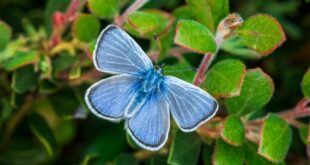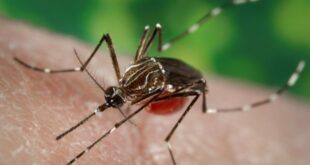3,600 beetles have been sent to N.S. to prey on hemlock-destroying invasive species.

When a tiny black beetle crawled out of a small white jar and onto the branches of a majestic Nova Scotia hemlock, it was a big moment — a potential solution to a huge problem.
“We think they’re probably our best bet,” said Lucas Roscoe, a research scientist with the Canadian Forest Service.
The beetles — officially Laricobius nigrinus — have been shipped across the country from their native British Columbia in a race against time to try to control the hemlock woolly adelgid, an invasive species killing Nova Scotia’s hemlock trees — some of which are hundreds of years old.
The beetles are coming to Nova Scotia as part of a new research program to see how effective they are in containing the invasive insects, and whether they are hardy enough to survive the East Coast winter and establish their own population there. Several federal and provincial agencies in both Nova Scotia and B.C. are involved in the project.
This is the first shipment of beetles to arrive, with another batch set to make the trip next fall.
The hemlock woolly adelgid, named for the white substance it leaves on branches, has a straw-like appendage in its mouth that allows it to suck nutrients out of trees, literally sucking the life out of them.
The invasive insects have already killed large swaths of hemlocks in the province. If they are allowed to continue unabated, it is expected 90 per cent of all Nova Scotia hemlocks will die within 10 to 15 years.

The hemlock woolly adelgid was first spotted in southern Nova Scotia in 2017 but has been rapidly moving north, and can now be found on nearly every tree in Kejimkujik National Park, about 160 kilometres west of Halifax. Hemlocks make up nine per cent of the park’s trees, which equates to thousands.
It is already creeping into Ontario and is expected to spread into New Brunswick and Quebec. It can also be found on the West Coast, but the beetles there keep it from killing the trees.
However, those beetles don’t naturally exist in Nova Scotia.
Researchers in B.C. are collecting the predators by shaking them out of trees, then shipping them across the country.
“It’s a great idea,” said Gwylim Blackburn, a research scientist at the Pacific Forestry Centre, during an interview in Victoria.
“Biological control, if it’s carefully designed, can be very effective, simply because the beetles themselves find hemlock woolly adelgid prey better than any of us can.”

About 3,600 beetles have arrived in Nova Scotia in the past two weeks, and when they were released at Kejimkujik, some immediately started eating the insects.
“It’s incredible,” said park ecologist Matthew Smith. “I mean, it’s a really, really good feeling because it can feel hopeless.”
Roscoe said it costs $40 per beetle to send the beetles across the country, which means this shipment — funded by both the Nova Scotia and federal governments — cost an estimated $144,000.
“It’s expensive up front, but the idea behind this is establishing a population in the province where it can actually self-replicate,” he said.
This is the first time this kind of biocontrol has been used in Canada, but the method has been used with these two species for more than 20 years in the United States.

Invasive species spreading rapidly
The hemlock woolly adelgid travelled to the Eastern United States from its original habitat in Japan. In Canada, Nova Scotia is ground zero.
“It can move around via birds. That’s probably how it got to Nova Scotia,” said Roscoe in an interview at Kejimkujik.
Roscoe said there is no concern the beetles will eat anything other than the problem insects, because hemlock woolly adelgid is their only food source.
Researchers are now conducting a mortality study to determine whether the beetles can survive an East Coast winter. They’ve put around 300 beetles in cages tied over the branches, which will allow the researchers to go back in February and again in the spring to see how they fared.
Scientists also treating hemlocks with pesticides
When hemlock woolly adelgid was discovered in Nova Scotia in 2017, pesticides to treat it were not approved for use in Canada. But now that they are, it’s another tool scientists are using to try to protect the hemlocks.

In 2020, scientists began using one method where they inject a chemical into the trunk of the tree. It takes a year and a half to make its way up into the canopy, but once it’s there, it protects the tree for five to seven years.
They can do this on 80 to 100 trees a day, but only during the spring and fall.

A new, faster, method that allows scientists to spray the bark of the tree was approved for emergency use in September.
They can treat up to 200 trees a day that way, but use of that pesticide is limited to 20 to 30 trees per hectare to ensure other insects in the ecosystem are not exposed.
Hemlocks are important for the integrity of the ecosystem.
They provide humidity for organisms such as lichens and fungi, shelter for birds and insects, and shade for brooks and streams that keeps them cool for trout and salmon, and mitigate the effects of climate change.

B.C. beetles to the rescue! Saving Nova Scotia hemlock trees
Nova Scotia’s hemlock trees are under threat of being wiped out by an invasive insect but scientists are hoping a beetle from British Columbia that eats the insect could hold the key to saving the tree species.
The old, large trees are also a source of nostalgia for some.
“A lot of people have cottages on lakes, and they may not know it, but a lot of the trees around them are hemlock trees,” said Smith. “So seeing those hemlock trees decline and die is really hard for a lot of people.”
ABOUT THE AUTHOR

Senior reporter
Kayla Hounsell is a network reporter with CBC News based in Halifax. She covers the Maritime provinces for CBC national news on television, radio and online. She welcomes story ideas at kayla.hounsell@cbc.ca.
*****
Credit belongs to : www.cbc.ca
 Atin Ito First Filipino Community Newspaper in Ontario
Atin Ito First Filipino Community Newspaper in Ontario






